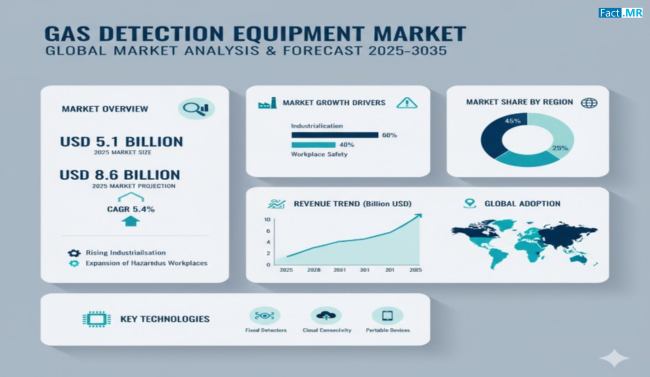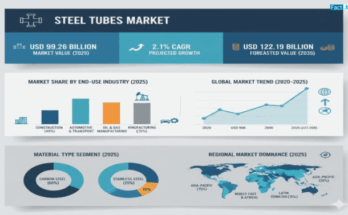In today’s industrial landscape, where safety and compliance are paramount, gas detection equipment has become an essential component across sectors such as oil & gas, manufacturing, mining, and healthcare. These systems play a critical role in identifying and monitoring hazardous gases to prevent accidents, ensure worker safety, and maintain environmental integrity. As industries continue to expand and automation advances, the demand for reliable, intelligent, and portable gas detection systems is steadily rising worldwide.
Market Overview
The gas detection equipment market encompasses a diverse range of devices designed to detect toxic, combustible, and oxygen-deficient gases in various industrial settings. These devices serve as vital safeguards, alerting operators to leaks or unsafe atmospheric conditions before they escalate into dangerous situations.
Driven by stringent occupational safety regulations, increasing awareness about workplace hazards, and technological innovation, the market is evolving rapidly. Modern gas detection systems are no longer just basic sensors; they now integrate advanced technologies such as wireless communication, cloud connectivity, and real-time analytics to enhance detection precision and response times.
Manufacturers are focusing on developing compact, energy-efficient, and multi-gas detectors that can seamlessly operate in harsh environments. The incorporation of smart features—such as data logging, remote monitoring, and predictive maintenance—is further elevating the performance and reliability of gas detection solutions across industries.
Regional Insights
North America remains one of the leading regions in the gas detection equipment landscape, supported by well-established industrial infrastructure and stringent safety standards. The presence of numerous oil & gas and petrochemical facilities necessitates the deployment of robust gas monitoring systems to mitigate explosion and exposure risks.
Europe is following a similar trajectory, with the region’s strong focus on workplace safety, environmental protection, and regulatory compliance. The adoption of gas detection technologies in sectors such as automotive, chemicals, and energy is reinforced by strict EU safety directives and sustainable industry goals.
Asia Pacific is witnessing significant expansion due to rapid industrialization, urbanization, and increasing energy demand. Rising investments in manufacturing and construction, particularly in countries like China, India, and Japan, are creating strong opportunities for gas detection system suppliers.
Meanwhile, Latin America and the Middle East & Africa are emerging as key growth regions, supported by the development of oil refineries, mining operations, and infrastructure projects. As regional safety awareness improves and regulations tighten, demand for gas detection equipment is expected to strengthen further.
Key Trends & Forecast
The gas detection equipment market is transforming rapidly, driven by digitalization, sustainability concerns, and the need for enhanced safety protocols. Key trends shaping the market’s future include:
- Adoption of Smart and Connected Detection Systems:
Integration of IoT and cloud-based monitoring enables real-time data transmission and remote management of detection systems. These smart devices allow for immediate response to leaks and hazardous conditions, improving workplace safety and operational efficiency. - Shift Toward Wireless and Portable Devices:
Wireless gas detectors are gaining popularity due to their flexibility and ease of installation. Portable handheld devices are increasingly preferred in field operations, allowing workers to monitor air quality in confined or dynamic environments. - Multi-Gas Detection Technologies:
Industries are adopting multi-gas detectors capable of monitoring several hazardous gases simultaneously. This versatility reduces equipment costs and enhances safety by providing comprehensive coverage in complex operational areas. - Sustainability and Energy Efficiency:
Manufacturers are developing low-power, long-lasting sensors and battery-efficient devices that align with sustainability objectives while maintaining accuracy and durability. - Integration with Automation and Safety Systems:
Modern facilities are linking gas detection systems with automated control units, ventilation systems, and emergency shutdown mechanisms to ensure immediate and coordinated responses during hazardous events. - Predictive Maintenance and Data Analytics:
The use of predictive algorithms and advanced analytics helps identify sensor degradation or calibration needs, minimizing downtime and optimizing equipment lifespan. - Rising Importance of Personal Safety Equipment:
The market is witnessing increased use of wearable gas detectors among industrial workers. These lightweight, compact devices provide continuous personal protection and can transmit alerts directly to safety managers.
Applications & End-Use Outlook
Gas detection equipment is deployed across multiple industries, each with unique safety requirements and environmental conditions:
- Oil & Gas Industry:
One of the most prominent end-users of gas detection systems, this sector relies on continuous monitoring of combustible and toxic gases to prevent leaks, fires, and explosions. Offshore platforms, refineries, and storage facilities all depend on advanced detection technologies. - Manufacturing and Industrial Plants:
Facilities involved in chemical production, metal fabrication, and pharmaceuticals use gas detectors to maintain safe air quality and ensure compliance with occupational health standards. - Mining Sector:
Gas detection systems are essential in mining operations to detect methane, carbon monoxide, and other toxic gases that can accumulate in confined tunnels and shafts. - Construction and Infrastructure:
The growing use of gas-powered equipment and confined work environments has led to an increasing need for portable detection systems to protect on-site personnel. - Healthcare and Laboratories:
Hospitals, research labs, and pharmaceutical environments deploy gas detectors to monitor oxygen levels, anesthetic gases, and chemical emissions to maintain sterile and safe conditions. - Environmental and Waste Management:
Gas monitoring solutions are crucial for detecting emissions and ensuring compliance with environmental regulations in waste treatment and landfill operations.
Competitive Landscape
The gas detection equipment market features a mix of global manufacturers and regional players, all competing through technological innovation, reliability, and after-sales service. Leading companies are investing heavily in R&D to develop advanced sensors with faster response times, higher sensitivity, and extended durability.
Strategic partnerships, mergers, and acquisitions are common as companies expand their global footprint and diversify product portfolios. Many firms are also focusing on developing integrated safety solutions—combining gas detection with fire alarms, emergency response systems, and real-time analytics—to provide comprehensive safety management platforms.
Additionally, manufacturers are aligning their offerings with global safety certifications and regulatory standards, ensuring compliance and trust among industrial users. Customized solutions tailored to specific industries and operational environments are helping companies gain a competitive edge.
Future Outlook
The future of the gas detection equipment market lies in digital transformation, automation, and sustainable innovation. As industries move toward smart manufacturing and Industry 4.0 practices, the role of connected safety systems will continue to expand.
Advancements in sensor miniaturization, wireless technology, and AI-powered data interpretation will make gas detection systems more responsive and adaptive. Integration with centralized safety networks will enable predictive hazard prevention, transforming workplace safety from reactive to proactive management.
Furthermore, the transition toward clean energy sources and carbon-neutral operations will continue to shape the design and application of gas detection solutions, particularly in sectors managing hydrogen, ammonia, and biofuels.
Conclusion
The gas detection equipment market stands as a cornerstone of industrial safety, protecting lives, assets, and the environment. As industries evolve and adopt smarter, cleaner, and more automated systems, gas detection technologies are becoming increasingly sophisticated, interconnected, and sustainable. The path forward lies in leveraging innovation, digital integration, and regulatory alignment to create safer, more efficient, and environmentally responsible industrial ecosystems.
Browse Full Report – https://www.factmr.com/report/460/gas-detection-equipment-market



